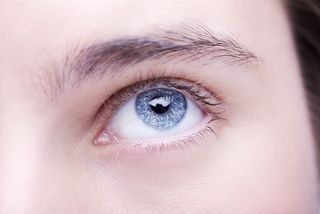Drug May Help with Common Form of Vision Loss

An experimental drug reduces eye damage in people with a common form of vision loss for which there is currently no available treatment, a new study finds.
The new research sought to treat age-related macular degeneration (AMD), the leading cause of vision loss in industrialized countries, according to the World Health Organization. The disease damages the macula, a tiny spot near the center of the retina, the light-sensitive part of the eye. The result is blurriness or a loss of vision straight ahead in a person's field of view, which can have a devastating impact on many daily activities, such as reading, driving or recognizing faces.
The new study included 129 participants ages 60 to 89 in the United States and Germany. All of the participants had a particular type of AMD called geographic atrophyAMD, or "dry AMD." In the 18-month trial, the participants who were given monthly injections of a drug called lampalizumab had a 20 percent reduction, on average, in the size of the area of the retina that is affected by the disease, compared with the control group that was given a placebo injection. [Eye Tricks: Gallery of Visual Illusions]
One group of patients in particular benefited from the drug, experiencing a 44 percent drop in the size of the area affected by the disease. A genetic analysis of these patients revealed that they shared a certain genetic mutation, according to the study, which was funded by the company Genentech.
"The most important implication of these results is that it shows how the genetics of a human disease may be critical for understanding the disease," study co-author Dr. Erich Strauss, a clinical scientist at Genentech, told Live Science. Such research "may guide the discovery of new therapeutic targets to treat the disease and define populations that may benefit most from treatment," he added.
"The fact that we now have something that can possibly slow down the progress of this disease is very exciting to the field, since nothing exists right now," Dr. Wai Wong, a retinal disease specialist at the National Eye Institute in Bethesda, Maryland, who did not take part in this study, told Live Science.
There are two main types of advanced forms of AMD: neovascular AMD, which is sometimes called "wet AMD," and geographic atrophy AMD, or dry AMD. Wet AMD is caused by the growth of abnormal blood vessels that leak fluid into the macula, while dry AMD is linked with the shrinkage of tissue and cell death in the macula. Both forms of advanced AMD occur at roughly the same rates, said study co-author Menno van Lookeren Campagne, an immunologist at Genentech in South San Francisco, California.
Sign up for the Live Science daily newsletter now
Get the world’s most fascinating discoveries delivered straight to your inbox.
There are a few clinical treatments available for people with wet AMD, such as laser surgery or drugs that block abnormal blood vessel growth. However, there are currently no approved treatments for dry AMD, which affects more than 5 million people worldwide, including nearly 1 million people in the United States, the researchers said.
The main reason there are treatments approved for wet AMD and not dry AMD is that discoveries were first made that could help combat the former and not the latter. Specifically, cancer research pioneer Dr. Judah Folkman of Harvard Medical School and his colleagues discovered ways to fight tumors by attacking their supply of blood, and this research proved useful in treating neovascular AMD, saidstudy co-author Brian Yaspan, a geneticist at Genentech.
In previous research, scientists discovered that certain genetic mutations that led to a high risk of AMD were involved with a part of the immune system known as the innate immune system. Unlike the "adaptive" part of the immune system, which remembers previous encounters with germs and destroys them when they invade again, the innate part of the immune system is less specific, attacking anything with common features of germs. [11 Surprising Facts About the Immune System]
The virtue of the innate immune system is that it can respond much more quickly to germs than the adaptive immune system can.
The drug that the researchers used in the study, lampalizumab, targets a component of the innate immune system known as the alternative complement pathway, which can lead to excess inflammation and cell death, the researchers said.
The researchers added that lampalizumab appeared to be safe. The study participants had only a few adverse side effects, such as dry eye, that the researchers suspected might be due to the drug, Strauss said. [7 Bizarre Drug Side Effects]
It remains uncertain why genetic mutations that can boost the risk of this disease persist in the human population. One possibility is that such genetic variants could boost innate immunity in a way that has helped people survive infections. However, "with the increase in life expectancy in the current world population, along with reduced exposure to lethal pathogens," a hyperactive innate immune system "has turned into a disadvantage rather than an advantage," Yaspan told Live Science.
The researchers cautioned that this drug appeared only to slow the disease, not stop it completely. This suggests there may be other avenues of attack against it, Strauss said.
"We need to find out a lot more about the biology of how this disease works," Wong said.
Wong noted that this study had relatively few patients, leaving its findings open to question. Strauss and his colleagues are now conducting a larger Phase 3 clinical trial with lampalizumab to evaluate its long-term safety and efficacy. Only then might the drug be considered for FDA approval.
The scientists detailed their findings online June 21 in the journal Science Translational Medicine.
Originally published on Live Science.


